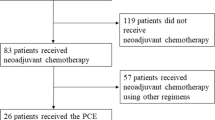Background and Purpose:
To investigate the role of postoperative concomitant chemoradioimmunotherapy in gastric adenocarcinoma patients.
Patients and Methods:
59 patients, who underwent total or subtotal gastrectomy, with lymph node involvement, positive microscopic surgical margins or serosal involvement were included in the study. Radiotherapy started concomitantly with chemotherapy and levamisole. Extended-field radiotherapy was given to gastric bed and regional lymphatics via two anterior-posterior/posterior-anterior fields. A total dose of 45 Gy in 25 fractions with a fraction size of 1.8 Gy was planned. In 28 patients (48%) with positive surgical margins a 10-Gy boost dose was given to the anastomosis site. An adjuvant i.v. bolus of 450 mg/m2/day 5-fluorouracil (5-FU) was administered concomitantly during the first 3 days and at the 20th day of irradiation. After completion of radiotherapy, i.v. boluses of 450 mg/m2/day 5-FU and 25 mg/m2/day rescuvorin were continued for 6 months once a week. Levamisole 40 mg/day orally was started at the 1st day of radiotherapy and also continued for 6 months. Median follow-up was 37 months (7–112 months).
Results:
Median survival was 23 months. Overall 3- and 5-year survival rates amounted to 35% and 14%, respectively. Median survival of the patients with positive surgical margins was 22 months. The 3- and 5-year locoregional control rates were 59% and 55%, respectively. The most common toxicity was upper gastrointestinal system toxicity, which was observed in 42 patients (71%). Four patients (7%) died on account of early toxic effects, and six (10%) could not complete treatment.
Conclusion:
Although 48% of the study population involved patients with microscopic residual disease, the survival results as a whole were satisfactory. However, due to high toxicity, radiotherapy must be delivered with the most proper techniques along with adequate nutrition and supportive care.
Hintergrund und Ziel:
Untersuchung der Rolle der postoperativen Radiochemotherapie bei Patienten mit Adenokarzinom des Magens.
Patienten und Methodik:
59 total oder subtotal operierte Patienten mit Adenokarzinom des Magens, die eine Invasion der Serosaoberfläche, einen Befall der regionären Lymphknoten oder positive Resektionsränder aufwiesen, wurden in die Studie eingeschlossen. Postoperativ wurde eine simultane Radiochemotherapie begonnen. Die Bestrahlung wurde in „Extended-field“-Technik über zwei Felder (anterior-posterior und posterior-anterior) mit einer Gesamtdosis von 45 Gy in 25 Fraktionen zu 1,8 Gy appliziert. 28 Patienten (48%) mit positiven Resektionsrändern erhielten zusätzlich einen 10-Gy-Boost auf den Anastomosenbereich. Die adjuvante Chemotherapie mit einem 450-mg/m2-Bolus 5-Fluorouracil (5-FU) wurde an den ersten 3 Tagen verabreicht und am 20. Tag wiederholt. Nach der Strahlentherapie erhielten die Patienten 450 mg/m2 5-FU i.v. und 25 mg/m2 Leukovorin i.v. wöchentlich für weitere 6 Monate. Die Immunmodulation mit 40 mg Levamisol p.o. wurde am 1. Bestrahlungstag begonnen und für 6 Monate weitergeführt. Der mediane Nachuntersuchungszeitraum lag bei 37 Monaten (7–112 Monate).
Ergebnisse:
Die mediane Überlebenszeit betrug 23 Monate. Die 3- und 5-Jahres-Gesamtüberlebensraten lagen bei 35% und 14%. Patienten mit positiven Resektionsrändern wiesen eine mediane Überlebenszeit von 22 Monaten auf. Die lokoregionale Kontrollrate betrug 59% nach 3 Jahren und 55% nach 5 Jahren. Die häufigsten Nebenwirkungen der Behandlung waren gastrointestinale Beschwerden bei 42 Patienten (71%). Vier Patienten (7%) starben infolge der Nebenwirkungen. Sechs Patienten konnten die Behandlung aufgrund von Nebenwirkungen nicht beenden.
Schlussfolgerung:
Obwohl 48% der Patienten in dieser Studie einen mikroskopisch nachweisbaren Resttumor aufwiesen, war die beobachtete Überlebenszeit verhältnismäßig gut. Aufgrund der hohen Toxizität sollte die Behandlung jedoch sehr sorgfältig unter Einsatz angemessener supportiver Maßnahmen durchgeführt werden.
Similar content being viewed by others
Author information
Authors and Affiliations
Corresponding author
Rights and permissions
About this article
Cite this article
Beşe, N.Ş., Büyükünal, E., Özgüroğlu, M. et al. Toxicity and Survival Results of a Phase II Study Investigating the Role of Postoperative Chemo-radioimmunotherapy for Gastric Adenocarcinoma. Strahlenther Onkol 181, 652–659 (2005). https://doi.org/10.1007/s00066-005-1399-2
Received:
Revised:
Issue Date:
DOI: https://doi.org/10.1007/s00066-005-1399-2




